We have been promoting a wide range of R&D activities systematically by coordinating between R&D sectors, including the R&D Directorates whose activities have been described in previous chapters and 12 R&D Centers located in various places in Japan.
The R&D Directorates of JAEA have been promoting R&D for their respective purposes with the experimental equipment/facilities at each R&D Center. The R&D Centers have not only been operating and managing various types of equipment/facilities but have also been working on innovations and improvements for them, and in addition have themselves been developing experimental techniques, management techniques and equipment/facilities necessary for various R&D projects of JAEA.
In this chapter, those developments which have been made over recent years at each R&D center are introduced.
Tsuruga Head OfficeFor the prototype FBR "MONJU", modification works including the exchange of thermometers of the secondary cooling system and the modification on sodium leakage countermeasures have been conducted. Following these modification works, functional tests of the improved components and systems will be carried out. We made a draft of a booklet of possible accidents and troubles during the functional tests and operation of " MONJU". 118 items are listed and their outlines, countermeasures, and preventative design considerations are described. "FUGEN" began the legal procedures for the decommissioning implementation last November. After that, its name and structure will be changed and the R&D activity on decommissioning technology will start. |
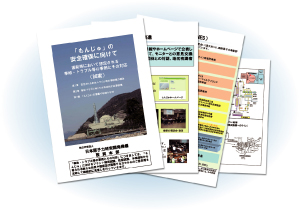 Booklet on possible accidents and troubles during the functional tests and operation of "MONJU" |
Tokai Research and Development Center, Nuclear Science Research Institute (NSRI)NSRI, as a Center of Excellence (COE) in nuclear research and development, has safely and successfully operated research reactors, tandem accelerators, criticality testing facilities and nuclear fuel facilities while conducting related technology development in order to fulfill various needs of these facilities. One technology developed at NSRI is advancement of a cure for virulent tumor by boron neutron capture therapy (BNCT) using research reactors. In 2006, NSRI has established a technique to irradiate patients in a seated position, to cure lung cancer. As a result, 34 irradiation treatments were conducted in 2006, many more than the 12 treatments of 2005. Meantime, NSRI also has been developing radiation calibration fields matching the national standard in order to establish the reliability of radiation measurements. These radiation calibration fields at the Facility of Radiation Standards have been available for common use since last November. |
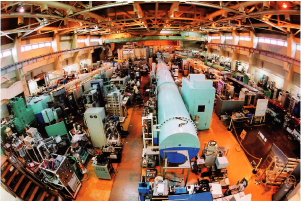 Japan Research Reactor No.3 beam hall at the 15th anniversary of its upgrade |
Tokai Research and Development Center, Nuclear Fuel Cycle Engineering LaboratoriesIn Tokai Reprocessing Technology Development Center, reprocessing experiments were carried out using fuel (11.7 tons, of which about 2.5 tons were mixed oxide) used up by " FUGEN". Moreover, experiments were carried out at the Plutonium Fuel Development Center to determine the manufacturing conditions etc. of the pellets with low density for "MONJU". Besides this, at the Tokai Reprocessing Technology Development Center, construction of the Low-level Radioactive Waste Treatment Facilities (LWTF) that started on March 20, 2002 was completed on September 15, 2006, and the test operation (cold test) have begun. |
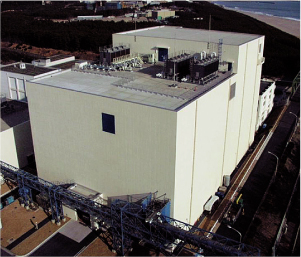 LWTF |
J-PARC CenterAt J-PARC, the construction of three buildings for the Linac, the 3 GeV Proton Synchrotron and the 50 GeV Proton Synchrotron, has been completed, and those accelerator components are being installed and tested. Linac, the first of these accelerators, has achieved a proton beam with an acceleration energy of 181 MeV, the initial goal, on January 24 this year. After adjustments are made to Linac during this year, the 3 Gev Proton Synchrotron and the 50 Gev Proton Synchrotron are scheduled to start the beam operation, aiming for the full operation of the J-PARC facilities in April, 2009. |
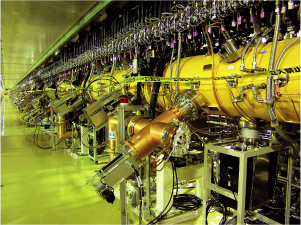 "Linac" First stage accelerator of J-PARC |
Oarai Research and Development CenterIn the development of Fast Breeder Reactor (FBR) cycle system technology, the development of the high burn-up fuel and the minor actinide containing fuel for FBR has been conducted using the experimental fast reactor "JOYO" and post irradiation examination facilities. Experimental research for the economic operation, safety and reliability of FBR, especially sodium safety handling technique has been was carried out using the sodium and its related test facilities. In the development of high temperature gas reactor, safety demonstration tests have been conducted using the High Temperature engineering Test Reactor (HTTR). The development of hydrogen production technology with the iodine-sulfur process and the thermochemical-electrolysis hybrid cycle have been conducted. Concerning nuclear reactors, the Japan Materials Testing Reactor (JMTR) obtained consent from the government for refurbishment, with restart planned in FY2011, and "JOYO" won the Nuclear Historic Landmark Award from the American Nuclear Society (ANS), since its contributions to the development of FBR cycle system technology for 30 years were highly evaluated. In activities as a member of the local society, the number of visitors of Oarai Science Museum exceeded 1,000,000, and Oarai Science Museum is contributing to the local community through education in science including nuclear technology. |
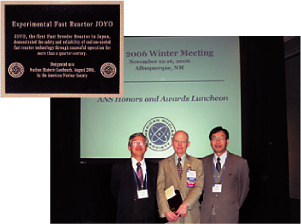 Takashi Nagata (left) |
Naka Fusion InstituteNaka Fusion Institute, in close cooperation with the Fusion R&D Directorate, aims at utilizing fusion energy for the future. Following the conclusion of the Agreement for ITER (to be built in France) in November 2006, the Agreement for Broader Approach Activities (to complement the ITER Project) with Europe was concluded in February 2007, and a project to upgrade JT-60 has been initiated as a part of this cooperation. In order to introduce the forefront of fusion R&D to the public, the Institute frequently organizes site tours for neighboring junior high school students, and for high school students from all over Japan (Super Science High Schools). Also, we open our site and some facilities to the local residents in October every year. |
 Local residents visited Naka on the Open-Site-Day |
Takasaki Advanced Radiation Research InstituteThe Takasaki Advanced Radiation Research Institute, opens its four ion accelerators at "TIARA", an electron accelerator, and γ-ray irradiation facilities to researchers both inside and outside JAEA for R&D on new functional or earth-friendly materials, biological technology, quantum beam analysis and radiation resistance tests of materials/apparatuses. In this fiscal year, the formation of a microbeam of 260-MeV Ne having a diameter less than 1 µm was achieved in vacuum for the first time in the world, and the fabrication of a fine 3D polymer structure with a depth/width ratio higher than 10 also was realized using proton beam writing technology. |
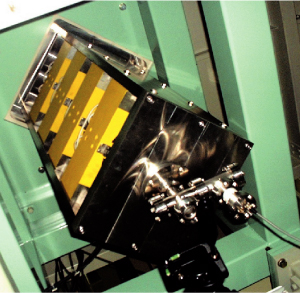 The quadrupole magnet system for formation of heavy ion microbeams of hundreds of MeV. |
Kansai Photon Science InstituteThe new project, creation of a "Photo Medical Industrial Valley", has been proposed in the "Formation of creative base for innovations integrating frontier fields" program funded by Special Coordination Funds for Promoting Science and Technology commissioned by the Ministry of Education, Culture, Sports, Science and Technology (MEXT), and a feasibility study has been commissioned in fiscal year 2006. Preparations for "Photo Medical Industrial Valley" construction were made in collaboration with industries and universities in the Keihanna region (extending over Kyoto, Osaka, and Nara prefectures, a new base of culture, science, and research for the 21st century.). Facility sharing began in fiscal year 2006, and faculties have been used by universities and the corporations in 57 cases. For public relations, there were openings of facilities to the public, cooperation in local events, science camps, science seminars, etc.. In the science museum, commemorative ceremony upon the 200,000th visitor and the fifth anniversary was held, and a Yamashiro Science festival and a teacher seminar were held in cooperation with the local board of education. |
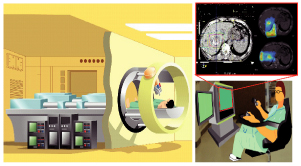 Compact laser-driven proton beam device for cancer treatment (concept) |
Horonobe Underground Research CenterAs part of the research into geological isolation technology to dispose of high-level radioactive waste collected from spent fuels of nuclear power plants safely, geological research, research and development on geological disposal technology, and joint research with other research laboratories and universities were carried out in the 2006 fiscal year. Moreover, the construction of an underground research laboratory and a public information house has progressed. The public information house opened June 30, in which corners for surveillance studies and publicizing the results thereof are set up. |
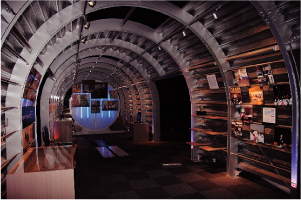 Inside the PR facility (corner introducing research and development of the Center) |
Tono Geoscience CenterWe conduct general Research & Development (R&D) on techniques for characterization of deep geological environments in granite, and on the long-term stability of a geological disposal of High-Level radioactive Waste (HLW). In 2006, we excavated two research shafts to the depth of 200.2m for the Main Shaft and 193.6m for the Ventilation Shaft. We also started the excavation of a sub stage horizontal tunnel at the depth of 200m by drilling pilot boreholes at the bottom of the shafts, and we investigated more in detail the geological conditions of the rock down to a depth of 500m. In July 2007, The Mizunami Underground Research laboratory celebrated its 5th anniversary of the start of its construction. |
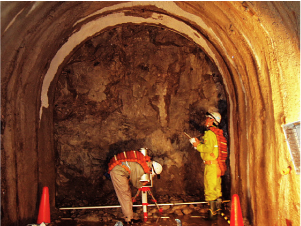 Geological inspection of a sub stage horizontal tunnel at the depth of 200m |
Ningyo-toge Environmental Engineering CenterThe Ningyo-toge Environmental Engineering Center has been developing the dry decontamination technology using iodine heptafluoride (IF7) gas as a part of decommissioning technology R&D for uranium enrichment facilities. The decontamination testing is being performed through JFY 2008 at the Uranium Enrichment Demonstration Plant. Development of wet decontamination technologies using diluted sulfuric acid is ongoing for decontamination technology of decommissioned gas centrifuges. Data acquisition has been carried out, including water level and chemical composition of ground water, to advance the reclamation of the Ningyo-toge Mine in the future. Preparation for the construction of a brick factory which will use waste rock from the Katamo Waste Rock Yards as raw materials, was started. |
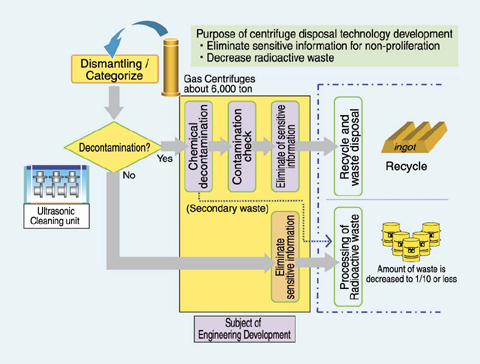 This Picture(287KB) General flowchart of the centrifuge disposal technology development |
Aomori Research and Development CenterTandetron AMS has had an open door policy for general users since Spring 2006. Tandetron AMS measured 1,094 graphite samples and 502 iodine samples in the fiscal year of 2006, the highest numbers in our history. At the same time, we have been developing a pre-treatment system for 14C in dissolved organic carbon which uses ultraviolet rays and 14C in the atmosphere. Also under development are pre-treatment methods for 129I in seawater and seaweeds. I n decommissioning the nuclear ship "MUTSU", radioactive wastes were surveyed and spent fuels were re-assembled for re-processing at the Hot Material Examination Facility in the Nuclear Science Research Institute. The decommissioning plan of "MUTSU" got approval from the Japanese regulating authority in October 2006. A symposium was held at Mutsu, Aomori in November for Environmental Sciences under the auspices of JAMSTEC (Japan Agency for Marine-Earth Science and Technology), JMSF (Japan Marine Science Foundation) and JAEA to give information about our activities to the local public. |
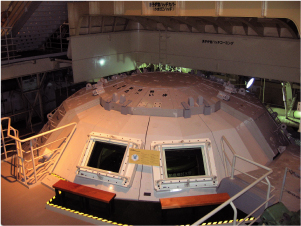 Reactor room of Nuclear ship "Mutsu" |